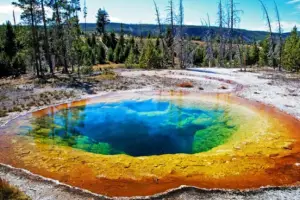
Thermophilic bacteria
Thermophilic bacteria are the bacteria that love to live in a high temperature. Thermophilic bacteria bacteria can survive in hot temperature.
Examples:
Thermus aquaticus and Sulfolobus solfataricus
Characteristics of Thermophilic bacteria:
The characteristics of Thermophilic bacteria are as follows:
- They can survive at extremely high temperature, such as 41ºC to 122ºC.
- Mostly thermophiles belong to Archaea group.
- They are commonly found in geothermal high temperature on Earth. They may be found in hot springs and deep-sea hydrothermal vents.
- They can decay organic matter easily.
- Their enzymes work best at high temperature.
- Their metabolism slows down at low temperature below 40ºC.
Classification of Thermophilic bacteria:
These bacteria are classified into three categories.
- Thermophiles.
- Extreme thermophiles.
- Hyper thermophiles.

Thermophiles:
These bacteria live in 40-65 ºC temperature. They are facultative thermophiles. They can tolerate the low temperature and grow best at high temperature. They slow down their metabolism at low temperature.
Extreme thermophiles:
These bacteria live in 65–79 °C temperature. They are obligate thermophiles. They can’t tolerate and survive in temperature below 50°C. They grow best at high temperature and die at low temperature.
Hyper thermophiles:
These bacteria grow at 80°C and beyond. They live in extreme conditions. They are usually anaerobes that use sulfur instead of oxygen during cellular respiration. They are usually acidophilic in nature that lives in low pH. They live in volcanoes, hot springs. They are usually colored bacteria due to the presence of photosynthetic bacteria.
How do Thermophilic bacteria survive?
These bacteria survive in an extreme environment because of their morphology and chemistry. Their cell wall is composed of polysaccharide that doesn’t melt in high temperature. Their enzymes work best at high temperature. Their enzymes don’t denature at high temperature and stabilize at high temperature.
Importance of thermophilic bacteria:
Thermophilic bacteria are very important as
- Their enzymes are used as molecular tools such as Taq. polymerase.
- Scientist considered as these bacteria are the origin of life on earth.
- These bacteria are used in industries to bear high temperature such as the textile industry.
- They are used as a source of heat-stable proteins and enzymes.
- They can use as a biocatalyst for the conversion of biomass into fuel.
- They are used in a waste management process.
Leave a reply